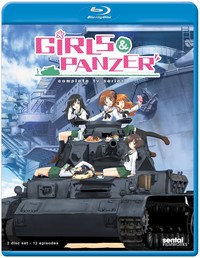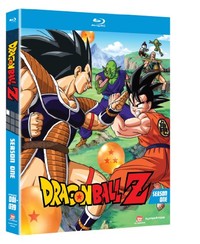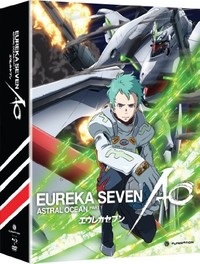Shelf Life
Girls und Anime
by Bamboo Dong,

Nothing this week
Rental Shelf
Girls und Panzer Complete Series BD
Eureka 7: AO Parts 1 and 2 BD+DVD
DBZ for People Who Like DBZ
Dragon Ball Z Season 1 BD
Perishable
Nothing this week
What about you? Do you still try and make resolutions?
But first, Shelf Life.
 Regardless of how you feel about Girls und Panzer, the show has done an incredible job of publicizing the city of Oarai in Japan, even winning an award from Ibaraki for improving the prefecture's image. The show is immensely popular in Japan, inspires hundreds of thousands of "anime holy site" pilgrims a year, and sells boatloads of merchandise. And… despite the show's hiccups and problems, it's easy to see why. Girls und Panzer is flat-out engaging.
Regardless of how you feel about Girls und Panzer, the show has done an incredible job of publicizing the city of Oarai in Japan, even winning an award from Ibaraki for improving the prefecture's image. The show is immensely popular in Japan, inspires hundreds of thousands of "anime holy site" pilgrims a year, and sells boatloads of merchandise. And… despite the show's hiccups and problems, it's easy to see why. Girls und Panzer is flat-out engaging.Initially, when Girls und Panzer was simulcasting, I ditched it fairly quickly because I was just girls 'n' guns'd out. The idea of sitting through a show whose premise involved girls driving tanks and shooting at each other just wore me out, mostly because I couldn't get over how improbable it was. And yet, when I forced myself to sit down and marathon the series, something curious happened. I realized that I didn't want to stop watching. Not because the show was spectacularly written—it has a mountain of pacing and plot development issues—and not because the characters are particularly fascinating—outside a couple of the main characters, we don't really learn anything about any of the giant cast of girls—but because the tanks themselves were fun to watch. They took on lives of their own, almost personifying their technical specifications on the battlefield. It was like watching a real-time strategy game, with players whose stats were directly affected by how much armor they were carrying, or their size. In essence, the tanks were better developed and more carefully written than their drivers, who oftentimes just embodied generic descriptors like "automobile club member" or "volleyball girl." Sure, the girls are plenty cute, and sure, the whole story is about Friendship(!) and Believing in Yourself(!), but it's the tanks that make the show.
Outside of the tanks, which are lovingly animated and meticulously researched, the show is on the sloppy side. The story moves forward in jerks and bounds; had the series been two seasons long, it could have spent a lot more time laying foundation. For instance, once the girls assemble their cadre of tanks, the show can pretty much be divided into two chunks: a scrimmage, then Nationals.
First of all, no one jumps straight to Nationals with just one practice match under their belt in any sport, be it baseball, basketball, or tankery. Gone are the episodes where the girls learn how to understand the strengths and weaknesses of their tanks, gone are the episodes of the girls tirelessly working on their aim, and gone are the critical scenes where main character Miho finds and embraces her style of sensha-do. Instead, these are replaced with short montages and throwaway dialogue, or in the latter case, the assumption that Miho is basically just some kind of strategy and risk-taking wunderkind. It not only makes the series a little jarring to watch, as it just hops from battle to battle, but it robs viewers of crucial bonding moments with the characters.
It also goes without saying that watching a show like Girls und Panzer requires a heavy suspension of disbelief. It is, after all, a show about an afterschool club where students get to blast each other with live tank rounds. I certainly have questions. For instance, if the girls had to rappel down a cliff in order to find a lost tank wedged in a hole in the side of a mountain, how did it get there? When they blow a hole into the side of a building during a match, who has to pay for repairs, the school or the government? Does the government even have that kind of money for a sporting event that seemingly only has a dozen or so observers in the stands for each match? What happens when one of the girls hits seriously hurt during a match, like when their tank falls through a bridge and plummets down a canyon, or someone gets impaled by a shell? I know it's just an anime, and I liked the series despite these red (white?) flags, but at times, they took me out of the moment.
One thing that I really enjoyed about the show, though, is the way it playfully uses country stereotypes to color the different tank teams. Although the various teams come from other Japanese high schools, they're all "themed" after different countries. The "American" high school plays loose and dirty and uses "The Battle Hymn of the Republic" as its theme. The "British" high school has characters named after tea, and who are always sipping tea. The "Russian" school is not only named after the Pravda newspaper, but also has a shield that mimicks the Soviet Union hammer and sickle. It reminds a little of Hetalia in its irreverency, though without the history lessons. I certainly got a kick out of watching the characters interact, though they, too, were hardly any more developed beyond their gimmicks.
At the end of the day, though, only one question needs to be answered, which is, "is this entertaining?" And the answer, despite my issues with the series, is still a resounding "yes." Girls und Panzer is deeply entertaining, sucking in viewers with its fast-paced action scenes and easy to digest episodes. It leaves much to be desired in terms of characterization, and takes a ton of narrative shortcuts, but once the battles start, it's difficult to stop watching. And really, sometimes that's all you need in a show.[TOP]
After my foray into sensha-do, I decided to stray into more familiar territory, circling back to one of anime's evergreen properties and perpetual cash-printing machines.
 It's a little hard to keep track of all the Dragon Ball/Z/GT releases that have come out over the years. It was only months ago that Funimation released the "Rock the Dragon" DBZ set, a nostalgia set for us 90s kids that grew up watching the Ocean dub on TV. Now they're dipping into the well again, this time with Blu-ray season releases that tout not only "a frame-by-frame restoration process to remove any blemishes, tape marks, and foreign bodies," but also "bolder, more vibrant color," and a reframing process that once again crops the original 4:3 aspect ratio for a widescreen 16:9.
It's a little hard to keep track of all the Dragon Ball/Z/GT releases that have come out over the years. It was only months ago that Funimation released the "Rock the Dragon" DBZ set, a nostalgia set for us 90s kids that grew up watching the Ocean dub on TV. Now they're dipping into the well again, this time with Blu-ray season releases that tout not only "a frame-by-frame restoration process to remove any blemishes, tape marks, and foreign bodies," but also "bolder, more vibrant color," and a reframing process that once again crops the original 4:3 aspect ratio for a widescreen 16:9. From a commercial standpoint, this absolutely makes sense. Despite the positive and negative fan hubbub that surrounds every DBZ release from Funimation, they are consistently some of the highest selling boxsets that the company releases. And, fans have been clamoring for a Blu-ray release for a while now (although Funimation tried already in 2011, and one could argue that the Kai releases fill the same void, minus copious hours of grunting and staring). But whether this double-/triple-/quadruple-(/quintuple-?)dip is necessary is a question that's hard to answer. Not only because everyone seems to have different criteria for their DBZ collections, but also because I think we still haven't arrived at The Definitive Dragon Ball Z release.
First, the positives. This Season One release bundles all 39 episodes of the first season onto a four-disc release, which at an MSRP of $44.98 is not bad, especially when you consider that at the time of writing, you can find it online for as low as $25. And, its audio options are pretty thorough, allowing viewers to watch not only in the original Japanese or (Funimation) English, but for the latter, choose between the English-version background music, or the Japanese (although annoyingly, "Chala Head Chala" is only in the Japanese version). (As a side note, it irritates me that the subtitles choose to use the pinyin "san xing qui" (three-star ball) to match Goku's use of the phrase in the Japanese script rather than just translating it to "three-star ball," because while I'm all for translation fidelity, I'd rather they localize under the assumption that their viewers don't know Mandarin.)
However, the release is not without some grievances. For starters, the "frame-by-frame restoration" championed by both the back-of-the-box copy as well as Funimation's ads appears to use a similar process as the 2007 remaster, using an automatic process that whisks out grain and blemishes at the sacrifice of fine detail. I'm of the camp that doesn't think DBZ was exactly crawling with detail to begin with, but there are certain shots where this is more noticeable. For instance, on objects in which like colors are used (pink houses with purple detailing), the process leaves them distractingly saturated and devoid of character. That may also have to do with the color correction process they used, which cranks up the brightness and vibrancy of the overall product. It's certainly an eye-opener, with zero trace of grain to be found, but lighter colors have a tendency to be a little too bright.
The most troubling is the widescreen crop. I'm no DBZ purist, and couldn't give less of a crap whether or not a few precious inches are lost on Bulma's shirt or Raditz's weird loin armor, but from a film-making perspective, some shots just don't look right. Characters are perpetually standing around with half their feet cut off, or with their chins missing, which doesn't work aesthetically. It also has the side effect of everyone's faces feeling insanely close up, like a director jammed a camera inches away from someone's cheek.
Personally, I firmly believe that people who are going to buy a Dragon Ball Z product are going to buy it no matter what someone on the internet says. The opposite is also true. However, I feel bound to admit that I don't think this is the best release that this series could possibly attain. If it were me, I'd hold off on this one.[TOP]
 Just what is a Scub Coral? A Scub is an alien who can't get no love from you; hangin' out with Secrets and G-Monsters, trying to holler at Generation Bleu.
Just what is a Scub Coral? A Scub is an alien who can't get no love from you; hangin' out with Secrets and G-Monsters, trying to holler at Generation Bleu.Eureka 7: AO (ayoooo!) takes place over a decade after the end of the original Eureka 7 timeline, introducing us to a teenager named Ao Fukai. He doesn't know it yet, but we've already met his parents—Eureka and Renton, although the full weight of that revelation, and the circumstances that led to Ao's current whereabouts aren't revealed until nearly the end of the series. "Who are Eureka and Renton?" some might ask right now.
Well, that's where viewers of the original series have the upper hand. While Eureka 7: AO can be watched on its own—there are plenty of things to lure in new viewers, like an impressive array of mech battles, superbly executed dogfights, and neon bright colors that will sock you in the retina—the full emotional impact of the series can't really be experienced unless you know who Eureka is. After all, her fate at the end of the first series, and her relationship to Ao is one of the crowning achievements of this sequel. Mind you, nothing is really accomplished until the last several episodes, but it's a satisfying payoff for what can be at times a frustrating viewing experience.
Regardless of if you're already familiar with Eureka 7, the first handful of episodes are a messy soup of plot threads. Even the basic building blocks are a little shaky, considering there are two types of bad guys (Scubs and Secrets), one of which has two different names (Secrets and G-Monsters). Luckily, there's only one group of good guys to contend with (Generation Bleu)… until you start dealing with all the geopolitical shenaniganery that's going on between various nations, some of whom we are led to believe are good (until they're bad) or bad (until they're good). It's not that the story can't be followed, it's just that it's presented in such a jumbled way that it's a little tedious to sort through it all, with nary a payoff until the end of the series.
Until then, there is plenty of eye candy to be had. Animated by the champions at BONES, Eureka 7: AO is a visual stunner, awash in bright, spectacular colors and highlighted by mech fights graceful enough to count as acrobatics. When you're not ogling the robots and aliens, there's plenty to gawk at on Earth, with stunning, detailed backdrops that give your eyes plenty of reason to play. It's wonderfully riveting and exciting to watch, which is merciful considering that the vast majority of the series seems to subscribe to the Bad Guy of the Week club.
Although Eureka 7: AO does have enough to keep newbie viewers entertained, it's not really tailored towards their best interests. Outside of the flash robot battles, the best thing the series has to offer are the insights into Eureka and Renton, none of which really manifest until the last act. Even then, if you have no prior investment in their lives, the resolution doesn't quite have the same effect. If you're a newcomer to the series, you're better off waiting until you've seen the original.[TOP]
That's it for this week. Next week, some sweet, sweet brotherly love.

This week's shelves are from "B.D." who wrote in the following:
"Hi there. I am a 12 year old high functioning autistic boy. Anime and manga really mean a lot to me as sometimes I feel like they're the only thing not silently judging me. I considered submitting this earlier but with my anime/manga haul this Christmas it was probably a good idea to wait on the pictures. Thanks for the awesome column."
Nice collection! Your collection looks way better than mine did when I was twice your age.
Want to show off your shelves? Send your jpgs to [email protected]. Thanks!
discuss this in the forum (70 posts) |




